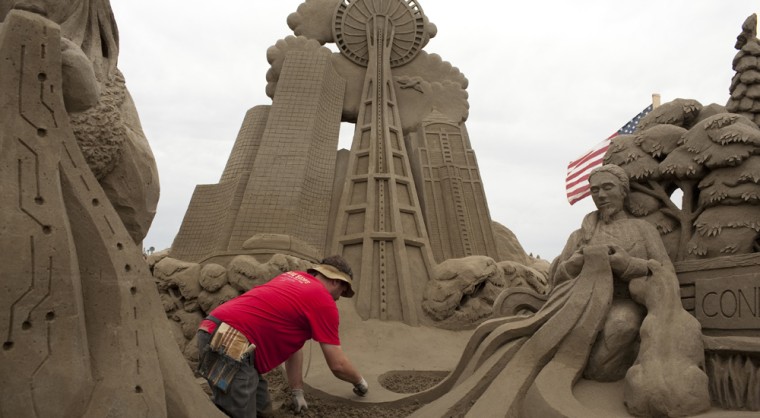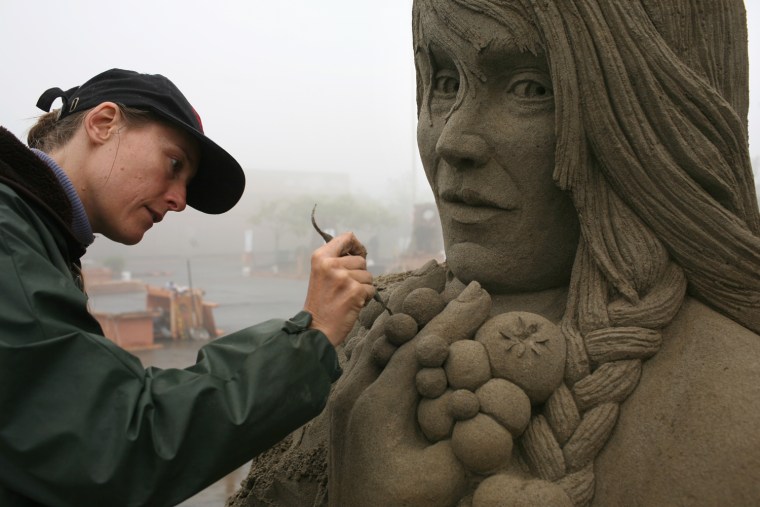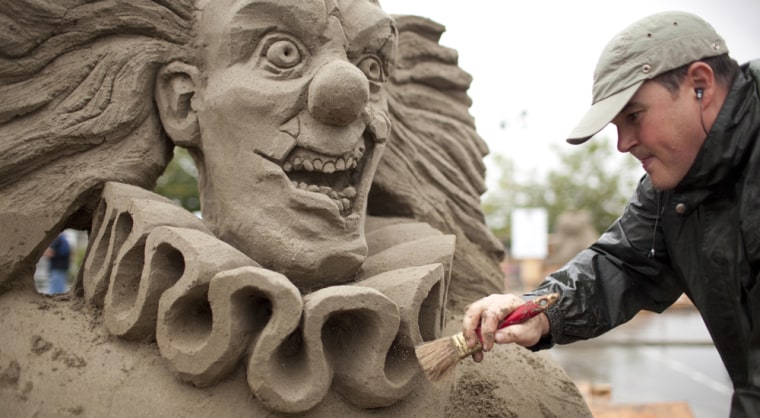Like time itself, a sand sculpture is inherently fleeting. For a brief period it stands there, tall and majestic, intricate and awe-inspiring — and then, as it's buffeted by the elements, it disappears.
How do the world's master sand sculptors deal with the transient nature of their craft?
"If the photos come out and the check clears, I'm OK with it," joked Damon Farmer, 61, of Kentucky.

Farmer was one of about 60 fun-loving artists from 17 countries who recently descended on a drizzly Seattle suburb to participate in the annual World Championship of Sand Sculpting. If the event's name conjures up images of standard sand castles built on the beach, think again.
Given license to go nuts with tons of glacial till, these precision sculptors spent days creating serious, high-caliber art. Charlie Beaulieu, 51, director of the World Championship event and a world champion sand sculptor himself several times over, said he was blown away by their creations.
"I see sand sculpting progressing from castles and dragons into museum pieces that could be cast in marble or stone," Beaulieu said. "It's becoming a truly authentic, solid art form."
'Ability of an athlete, skill of a surgeon'
Indeed, over the past 25 years or so, sand sculpting has come into its own both as an art form and as a way to make a decent living for a small band of high-end sculptors around the world. These artists crisscross the planet making mind-blowing creations out of sand for corporate clients, big events and international competitions — and theirs is such a small world that they bump into each other all over the place.
Doc Reiss, one of the organizers of the World Championship of Sand Sculpting, described this year's main event in Federal Way, Wash., as an extra-special "gathering of the clan."
"The best of the best are here," Reiss said. "They're competitors, but there's real camaraderie between them. They'll stop what they're doing and help each other."
Some — but not all — of these artists have training in fields such architecture, engineering and landscape design, and a few are actually surgeons. Many are accomplished sculptors who also work with wood, stone, ceramics and ice. And all of them have one thing in common: In order to create such massive sand sculptures, they have to be in excellent physical shape. Each artist must tackle the back-breaking challenge of shoveling, packing and pounding tons and tons and tons of sand on a tight deadline.
The first day of the World Championship competition is known as the "pound up" day. Sand sculptors ranging in age from 24 to 68 spend that day shoveling more than 33,000 pounds of sand into wooden forms that eventually get removed. The objective: To get the sand wet and compact it down, down, down so it becomes firm and stable enough to be transformed into high-flying, whimsical shapes.
Artists don't use beach sand; it tends to fall apart more easily because each granule has rounded, eroded edges after being worn down by waves. Instead, they use special sand purchased with the event in mind: A glacial till deposited in the last ice age.
"Microscopically this sand is very jagged," event organizer Reiss explained. "This is how we're able to get the verticality, or the ability to get so tall. ...
"This is an art sport," Reiss continued. "You have to have the physical ability of an athlete and the skill and precision of a surgeon."
After the pound up is finished, artists climb to the top of their creations, remove the first wooden forms and start carving. They either work alone on solo creations, or tackle projects as part of doubles teams or larger teams of four to six people.
They have four long and intense days to complete their creations.
Sand changed course of his life
Artist Paul Hoggard, 45, who originally hails from England, still remembers his first foray into sand sculpting almost 20 years ago.
"It all began while I was traveling in India," he said. "I was sitting there in paradise, on a sandy beach complete with a coconut tree, and I started to play in the sand like a child. All of a sudden I saw a face looking back at me. It was quite a powerful experience, actually."
Hoggard was hooked. The more involved he became in sand sculpting, the more doors opened to him. Sand sculpting has made it possible for him to travel all over the world and make a good living. (A single race car he sculpted out of sand for a corporate client brought in $15,000, for example.) In 2000, the Queen of England herself commissioned a sand sculpture from Hoggard. She requested a farm scene, so he sculpted a mother pig nursing 10 baby piglets. He got to present it to Her Majesty in person.

"She said, 'Oh, did you make that?' and I said, 'Yes, I did!'" Hoggard recalled with a big smile.
Sand continued to pay big dividends in Hoggard's life in 2003. That's when he met his future "sand woman," Remy Geerts, now 39, who is originally from the Netherlands. They were both at a big sand-sculpture theme park at the time.
"I was up on a 62-foot pile of sand when I saw her," Hoggard said. "I like to tell people that we fell in love on the biggest pile of sand in Europe."
Today the couple live on a farm they bought in Bulgaria with their sand-sculpting earnings.
"We live a quiet, healthy life growing our own food on our farm," Hoggard said.
Sand vs. ice
Marc Lepire, 37, of Quebec, Canada, began sculpting sand more than 10 years ago, but for most of his life his first love has been ice sculpting.
"I did my first ice sculpture when I was 13 years old," he said. "So for about 24 years now, I've been doing ice sculpting almost every single day."
Lepire is so good at his craft that he's called upon each year to carve the furniture for the Ice Hotel in Quebec. "I work 12 to 15 hours a day, no break, for two months from the first week in December until the last week in January," Lepire said of his contributions to the 75-bedroom hotel, which is constructed almost completely out of ice. "Beds, desks, chairs — you name it, I carve it."

Despite his passion for ice, Lepire said sand definitely has its advantages. Sand sculpting allows him to work outside in beautiful places, travel all over the world and make great friends.
"I swear, I've seen these same people here all around the world," Lepire said at the World Championship.
During the competition, he participated in the solo division and meticulously carved a scary-looking clown.
"Three days ago I watched the movie 'Zombieland' with my son, and that's how I got this idea — to make a bad clown with a big chainsaw!" he said.
Lepire said he fully embraces the temporary nature of creating sculptures out of sand and ice.
"I'll also do wood for more money, but with a wood sculpture you have to take care of it, put it somewhere — pah!" Lepire said. "The best kind of art is temporary. Really, it is. You just get a new block of ice or some new sand and start again."
Saying goodbye
The ephemeral quality of sand sculpting is actually quite a draw for many master sculptors.
"It's about the process of creation, that's what the enjoyable bit is," artist Hoggard said. "That's where we lose ourselves, that's where we forget about our bodies and we just work. ... We're attached to the process of making sculptures but not attached to the end result at all."
Organizers of the World Championship likened the art form to theater, or to a championship sporting event — once it's over, it's over.
"I think it's just like life itself — if you don't live in the moment you can't count on tomorrow coming around and supplying you with what you might miss today," event director Beaulieu said. "Go out and enjoy every day to the fullest."
Still, saying goodbye can be hard, even if it's unavoidable.
"It's always a lesson in letting go," said Farmer, the sculptor from Kentucky. "You do get attached, but you just have to let go."
Need a Coffey Break? Friend TODAYshow.com writer Laura T. Coffey on or follow her on .